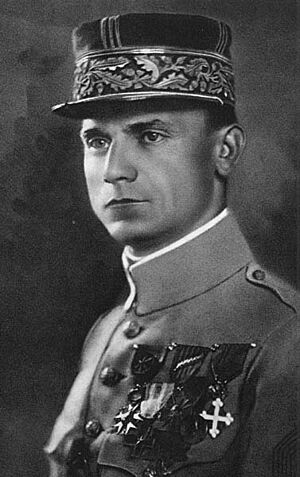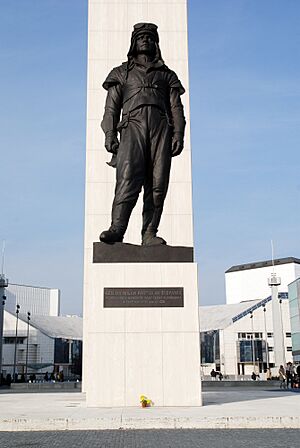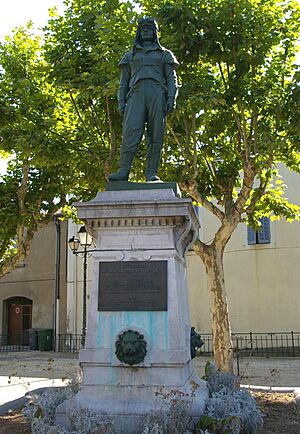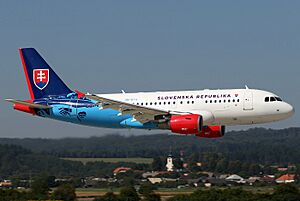Milan Rastislav Štefánik facts for kids
Quick facts for kids
Milan Rastislav Štefánik
|
|
|---|---|
 |
|
| 1st Minister of War of Czechoslovakia | |
| In office 28 October 1918 – 4 May 1919 |
|
| Personal details | |
| Born | 21 July 1880 Kosaras, Nyitra County, Kingdom of Hungary, Austria-Hungary (now Slovakia) |
| Died | 4 May 1919 (aged 38) Ivanka pri Dunaji, Czechoslovakia (now Slovakia) |
| Resting place | Brezová pod Bradlom, Slovakia |
| Occupation | Military, astronomer, mathematician, aircraft pilot, meteorologist |
| Awards | Légion d'honneur Croix de guerre 1914–1918 (France) Medal for the War Wounded(France) War Merit Cross (Italy) Order of Saints Maurice and Lazarus Order of Saint Vladimir Czechoslovak War Cross 1918 Order of the White Lion |


Milan Rastislav Štefánik (born July 21, 1880 – died May 4, 1919) was a very important Slovak person. He was a politician, a diplomat, a pilot, and an astronomer. During World War I, he was a general in the French Army. He also served as the Minister of War for Czechoslovakia.
Štefánik was a key member of the Czechoslovak National Council. This group worked to create an independent Czechoslovakia. He helped make sure that the Czech and Slovak lands became their own country. This happened just before the Austro-Hungarian Empire broke apart in 1918.
His personal motto was: "To Believe, To Love, To Work."
Contents
Early Life and Education
Milan Rastislav Štefánik was born in a place called Kosaras (now Košariská, Slovakia). This was on July 21, 1880. He had many brothers and sisters. His father was a pastor, and his mother was Albertína Jurenková.
He went to schools in different cities like Bratislava and Prague. In 1898, he started studying engineering. But in 1900, he changed to Charles University. There, he learned about astronomy, physics, and philosophy.
Studying in Prague
His time in Prague was very important. He met many famous people there. One of his teachers was Tomáš Garrigue Masaryk. Masaryk later became the first president of Czechoslovakia. He inspired Štefánik to work for cooperation between Czechs and Slovaks.
Štefánik was very active in a Slovak student group called Detvan. He also wrote articles to tell Czechs about the difficult situation of Slovaks. He finished his studies in 1904. He earned a doctorate in philosophy. His main interest was astronomy. His final paper was about a star discovered in 1572.
A Life in Science
In 1904, Štefánik moved to Paris. He wanted to find a job in astronomy. At first, he had no money and didn't speak French well. But he was very talented. He got a job at the famous Paris Observatory. The director, Pierre Janssen, saw his potential.
Janssen and another scientist, Camille Flammarion, helped Štefánik a lot. The observatory was a top place for astronomy. Working there gave him a lot of respect.
Exploring the Skies
Between 1905 and 1908, Štefánik did many important observations. He climbed Mont Blanc several times to study the Moon and Mars. He also joined a French trip to Spain. There, he observed a full Sun eclipse. These efforts made him well-known in French science.
His studies and findings were published. He also received several awards for his work. In 1907, he won the Prix Jules Janssen. This is a very high award from the French astronomical society.
Global Expeditions
After 1907, Štefánik traveled the world. He was sent by French authorities for astronomy and weather observations. He visited many countries, including Algeria, Russia, India, and the United States. He also went to places like Tahiti, where he built an observatory.
These trips also had a secret purpose. He was doing political tasks and gathering information. In South America, he showed his skills as a diplomat for the first time.
In 1912, Štefánik led a French mission to Brazil. They went to observe a solar eclipse. He brought special equipment for the Brazilian National Observatory. This included a large telescope. His contributions helped advance science in Brazil.
Štefánik focused on astrophysics. He was known for studying the Sun's outer layer, called the solar corona. He also worked on improving ways to study light from stars. He even tried to invent a machine for color photography.
Diplomatic Missions
Besides his science trips, Štefánik also worked as a diplomat. He made friends with many important people. These included scientists, artists, politicians, and business leaders. He helped set up businesses in France and other countries.
Among his friends were famous people like Gustave Eiffel, who designed the Eiffel Tower. In 1912, he became a French citizen. This gave him access to important people in France. In 1917, he received a high honor, the Grand Officier of the Legion of Honour.
At this time, Štefánik also had health problems. He was very sick with a stomach illness. But then, World War I started in Europe.
World War I and Independence
Štefánik believed that if Austria-Hungary and Germany lost the war, Slovaks and Czechs could become independent. So, he joined the French army. He trained to be a pilot. He flew many missions over enemy territory.
In 1915, he became very ill. A French pilot, Louis Paulhan, flew him to safety. This was one of the first "medical evacuations" by plane.
Forming Czechoslovakia
At the end of 1915, Štefánik returned to Paris. He met Edvard Beneš and reconnected with his old professor, Masaryk. In 1916, these three men created the Czechoslovak National Council. This group worked to create an independent Czechoslovakia. Štefánik later became the vice president of the council.
Štefánik's diplomatic skills were very important. He helped Masaryk and Beneš meet with leaders of the Triple Entente. These were the main Allied powers in the war. He helped them get support for their idea of a new country.
In 1916, Štefánik and the council started to organize the Czechoslovak Legions. These were groups of soldiers who fought against Austria-Hungary and Germany. Štefánik traveled to Russia and the United States to help organize these legions. He also set up legions in France and Italy.
Thanks to his efforts, the Allied powers recognized the Czechoslovak National Council. They saw it as a real government. They also recognized the Czechoslovak Legions as allied forces in 1918.
In May 1918, Štefánik went to Siberia. He wanted to gather the Czechoslovak legions there. Russia had left the war, and he hoped to restart fighting on the Eastern Front. The legions rebelled against an order to disarm. This gained them support from the Allies.
The New Nation
After the war ended in January 1919, Štefánik went to France and Italy. He helped bring Czechoslovak troops from Siberia back to Paris. He also used his diplomatic skills to solve problems between French and Italian groups in Czechoslovakia.
He went to Rome to talk with the Italian Ministry of War. There, he met his fiancée for the last time. Then, he went to an Italian military base. He arranged for the Italian military mission in Czechoslovakia to end.
Štefánik had a good relationship with Masaryk and Beneš. Telegrams from him show his support for the union of Czechs and Slovaks. He wrote to Masaryk, calling him "venerable professor" and the "first president of the Czechoslovak Republic." He also expressed loyalty to the council.
Masaryk trusted Štefánik completely until the end of his life. Štefánik was still working to solve problems with military groups in Czechoslovakia just days before he died.
His Tragic Death
Milan Rastislav Štefánik wanted to fly home to see his family. He took an Italian military plane, a Caproni Ca.3. On May 4, 1919, his plane tried to land near Bratislava. This area was a conflict zone at the time. The plane crashed near Ivanka pri Dunaji.
Štefánik died in the crash. The two Italian pilots and a mechanic also died.
There were rumors that the plane was shot down. Some thought it was mistaken for a Hungarian plane. However, an Italian eyewitness said something different. He reported that the plane's engines overheated during the first landing attempt. Then, during the second attempt, one engine exploded. This caused the crash.
The official report from the Italian investigation said that it was not caused by human error or problems with the plane's manufacturing.
Legacy and Honors
Štefánik's tomb was built between 1927 and 1928. It is on Bradlo Hill in Brezová pod Bradlom. The memorial is large but simple. It was designed by Dušan Jurkovič.
Many things are named after him to honor his memory:
- A minor planet discovered in 1982 is named 3571 Milanštefánik.
- Bratislava Airport is called M.R. Štefánik Airport.
- Aircraft of the Slovak Government Flying Service have his portrait painted on them.
- The Slovak Armed Forces Academy is named after him.
- A transport wing of the Slovak Air Force is also named after him.
In 2019, Slovakia released a special 2 euro commemorative coin. It marked 100 years since his death. Also in 2019, Štefánik was chosen as the "Greatest Slovak" in a TV show.
In 2020, a film was made about him called "Visionary of Slovak Freedom."
Awards and Recognitions
Štefánik received many awards for his service.
- In France, he received the Legion of Honour at different ranks. He also got the Croix de guerre and the Medal for the War Wounded.
- In Italy, he was given the War Merit Cross and the Officer rank of the Order of Saints Maurice and Lazarus.
- In Russia, he received the Order of Saint Vladimir.
- After his death, he was awarded the Czechoslovak War Cross 1918.
- In 2023, he was also given the Order of the White Lion 1st class by the Czech president.
See also
- History of Slovakia
- History of Czechoslovakia
- M. R. Štefánik Airport
- List of firsts in aviation




